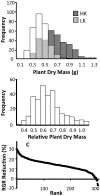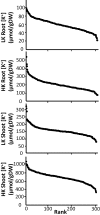A role for the OsHKT 2;1 sodium transporter in potassium use efficiency in rice
- PMID: 30854552
- PMCID: PMC6946003
- DOI: 10.1093/jxb/erz113
A role for the OsHKT 2;1 sodium transporter in potassium use efficiency in rice
Abstract
Increasing the potassium use efficiency (KUE) of crops is important for agricultural sustainability. However, a greater understanding of this complex trait is required to develop new, high-KUE cultivars. To this end, a genome-wide association study (GWAS) was applied to diverse rice (Oryza sativa L.) genotypes grown under potassium-stressed and -replete conditions. Using high-stringency criteria, the genetic architecture of KUE was uncovered, together with the breadth of physiological responses to low-potassium stress. Specifically, three quantitative trait loci (QTLs) were identified, which contained >90 candidate genes. Of these, the sodium transporter gene OsHKT2;1 emerged as a key factor that impacts on KUE based on (i) the correlation between shoot Na+ and KUE, and (ii) higher levels of HKT2;1 expression in high-KUE lines.
Keywords: Fertilizer use; GWAS; HKT2;1; potassium; potassium use efficiency; rice; sodium; sustainable agriculture.
© Society for Experimental Biology 2019.
Figures







Similar articles
-
Differential sodium and potassium transport selectivities of the rice OsHKT2;1 and OsHKT2;2 transporters in plant cells.Plant Physiol. 2010 Jan;152(1):341-55. doi: 10.1104/pp.109.145722. Epub 2009 Nov 4. Plant Physiol. 2010. PMID: 19889878 Free PMC article.
-
OsHKT2;2/1-mediated Na(+) influx over K(+) uptake in roots potentially increases toxic Na(+) accumulation in a salt-tolerant landrace of rice Nona Bokra upon salinity stress.J Plant Res. 2016 Jan;129(1):67-77. doi: 10.1007/s10265-015-0764-1. Epub 2015 Nov 17. J Plant Res. 2016. PMID: 26578190
-
K+ transport by the OsHKT2;4 transporter from rice with atypical Na+ transport properties and competition in permeation of K+ over Mg2+ and Ca2+ ions.Plant Physiol. 2011 Jul;156(3):1493-507. doi: 10.1104/pp.110.168047. Epub 2011 May 24. Plant Physiol. 2011. PMID: 21610181 Free PMC article.
-
A conserved primary salt tolerance mechanism mediated by HKT transporters: a mechanism for sodium exclusion and maintenance of high K(+)/Na(+) ratio in leaves during salinity stress.Plant Cell Environ. 2010 Apr;33(4):552-65. doi: 10.1111/j.1365-3040.2009.02056.x. Epub 2009 Nov 4. Plant Cell Environ. 2010. PMID: 19895406 Review.
-
Genetic dissection of root morphological traits as related to potassium use efficiency in rapeseed under two contrasting potassium levels by hydroponics.Sci China Life Sci. 2019 Jun;62(6):746-757. doi: 10.1007/s11427-018-9503-x. Epub 2019 May 5. Sci China Life Sci. 2019. PMID: 31069628 Review.
Cited by
-
Natural variations of chlorophyll fluorescence and ion transporter genes influenced the differential response of japonica rice germplasm with different salt tolerances.Front Plant Sci. 2023 Mar 17;14:1095929. doi: 10.3389/fpls.2023.1095929. eCollection 2023. Front Plant Sci. 2023. PMID: 37008489 Free PMC article.
-
Rice breeding for low input agriculture.Front Plant Sci. 2024 Jun 21;15:1408356. doi: 10.3389/fpls.2024.1408356. eCollection 2024. Front Plant Sci. 2024. PMID: 38974981 Free PMC article. Review.
-
Effects of improved sodium uptake ability on grain yields of rice plants under low potassium supply.Plant Direct. 2022 Apr 12;6(4):e387. doi: 10.1002/pld3.387. eCollection 2022 Apr. Plant Direct. 2022. PMID: 35434473 Free PMC article.
-
Variety-Specific Transcriptional and Alternative Splicing Regulations Modulate Salt Tolerance in Rice from Early Stage of Stress.Rice (N Y). 2022 Nov 3;15(1):56. doi: 10.1186/s12284-022-00599-9. Rice (N Y). 2022. PMID: 36326968 Free PMC article.
-
Constitutive Contribution by the Rice OsHKT1;4 Na+ Transporter to Xylem Sap Desalinization and Low Na+ Accumulation in Young Leaves Under Low as High External Na+ Conditions.Front Plant Sci. 2020 Jul 30;11:1130. doi: 10.3389/fpls.2020.01130. eCollection 2020. Front Plant Sci. 2020. PMID: 32849692 Free PMC article.
References
-
- Allen AG, Cardoso AA, Wiatr AG, Machado CMD, Paterlini WC, Baker J. 2010. Influence of intensive agriculture on dry deposition of aerosol nutrients. Journal of the Brazilian Chemical Society 21, 87–97.
-
- Asher CJ, Ozanne PG. 1967. Growth and potassium content of plants in potassium cultures maintained at constant potassium concentrations. Soil Science 103, 155–161.
-
- Aulchenko YS, Ripke S, Isaacs A, van Duijn CM. 2007. GenABEL: an R library for genome-wide association analysis. Bioinformatics 23, 1294–1296. - PubMed
-
- Benjamini Y, Hochberg Y. 1995. Controlling the false discovery rate: a practical and powerful approach to multiple testing. Journal of the Royal Statistical Society, Series B (Methodological) 57, 289–300.
Publication types
MeSH terms
Substances
Grants and funding
LinkOut - more resources
Full Text Sources
Medical

